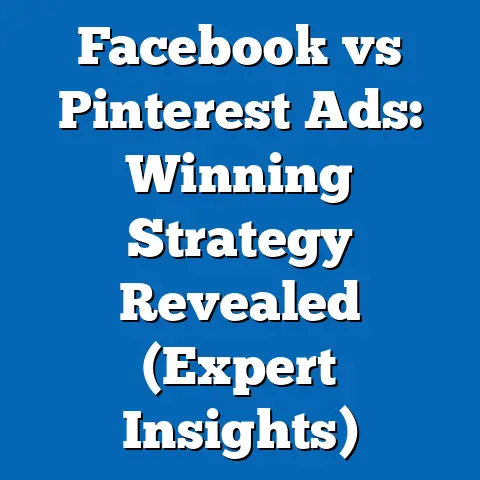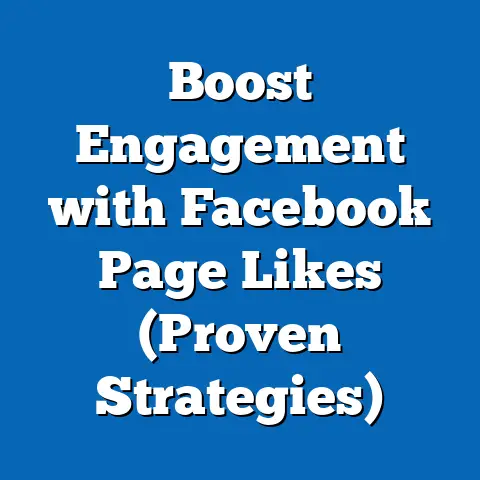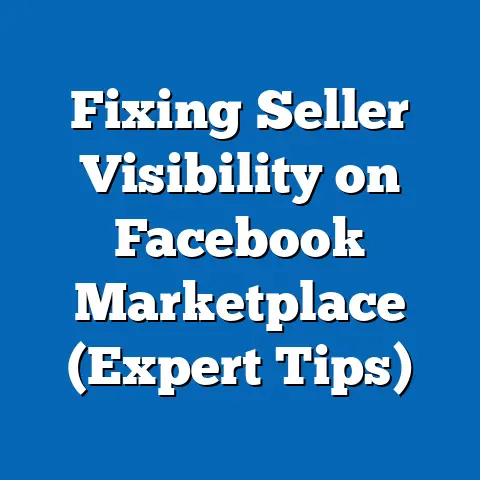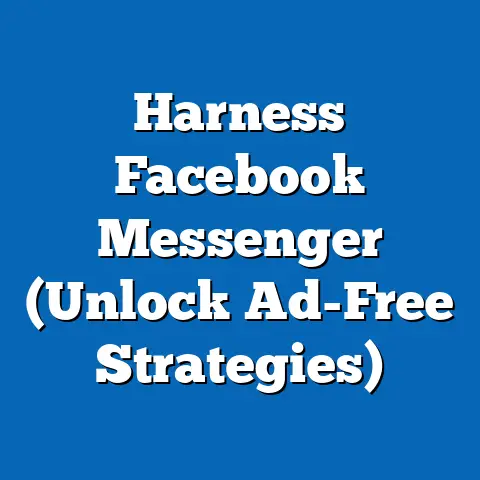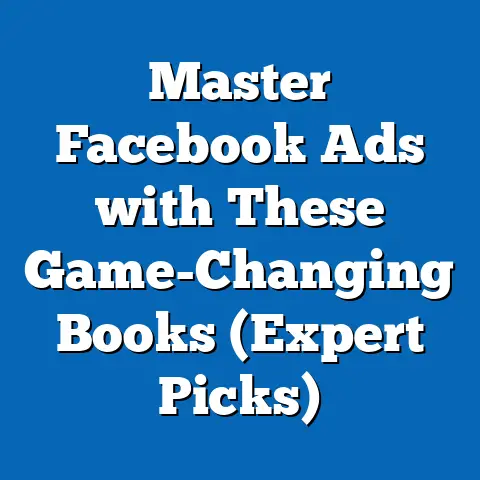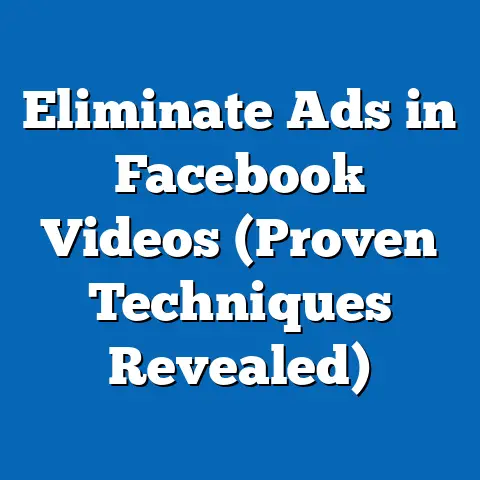Max Facebook Ad Accounts (Unlocking Creative Potential)
The digital advertising landscape is a crowded and competitive arena. As business owners, marketers, and brands, we’re all vying for attention in the same digital spaces. Facebook, with its billions of users, remains a crucial platform, but the limitations imposed by the number of ad accounts available to us can often feel like a significant hurdle. I’ve personally felt the frustration of hitting those limits, especially when trying to scale campaigns across diverse product lines or target niche audiences. It’s easy to feel stifled, as if your creative potential is being choked by these restrictions.
But what if I told you that these limitations, while challenging, could actually be a catalyst for greater innovation and more impactful advertising? What if, instead of seeing the ad account limit as a roadblock, we viewed it as an opportunity to refine our strategies, optimize our creative, and ultimately, achieve better results? This article will explore exactly that – how to unlock the creative potential within the constraints of Facebook ad accounts and transform limitations into advantages. We’ll delve into actionable strategies, real-world examples, and future trends to help you maximize your Facebook advertising efforts.
Understanding Facebook Ad Accounts
Let’s start with the basics. What exactly is a Facebook ad account, and why is it so important?
Simply put, a Facebook ad account is the central hub for managing all your Facebook advertising activities. It’s where you create, run, and track your ad campaigns. Think of it as your personal control panel for reaching Facebook’s massive audience.
Within each ad account, you’ll find a hierarchical structure:
- Campaigns: These are the overarching objectives of your advertising efforts. Are you trying to generate leads, drive website traffic, or increase brand awareness? Your campaign defines the overall goal.
- Ad Sets: Within each campaign, ad sets allow you to define your target audience, budget, and schedule. This is where you specify who you want to reach, how much you’re willing to spend, and when you want your ads to run.
- Ads: Finally, the ads themselves are the individual creative assets that users see on Facebook and Instagram. This includes the images, videos, headlines, and descriptions that make up your advertising message.
The challenge arises when you want to run multiple campaigns targeting different audiences with distinct creative approaches. While it’s easy to create many campaigns, ad sets, and ads, Facebook limits the number of ad accounts you can have. I remember when I first started running ads for my e-commerce store, I quickly realized that I needed separate ad accounts for different product categories and target demographics. But finding a way to manage them all was a challenge, and I quickly understood the limits.
These limitations can manifest in several ways:
- Restricted Testing: It becomes difficult to A/B test multiple ad variations simultaneously across different audiences.
- Limited Scalability: Scaling campaigns to new regions or demographics requires careful planning and prioritization.
- Creative Stagnation: The pressure to maximize limited resources can lead to repetitive messaging and a lack of innovation.
Facebook’s policies regarding ad account limits are designed to prevent abuse and maintain the quality of the advertising ecosystem. While the exact number of ad accounts allowed varies depending on several factors, the principle remains the same: you need to be strategic about how you use your resources. Violating these policies can lead to account suspensions, which can be a major setback for your business.
Key Takeaway: Facebook ad accounts are the foundation of your advertising efforts, but their limitations can present challenges for scaling and diversifying your campaigns. Understanding these limitations is the first step towards unlocking creative potential within the constraints.
The Importance of Creative Strategy in Advertising
In the crowded digital landscape, simply having a product or service to sell isn’t enough. You need to capture attention, resonate with your audience, and ultimately, persuade them to take action. That’s where creative strategy comes in.
Creative strategy is the art and science of crafting compelling advertising messages that connect with your target audience on an emotional level. It’s about understanding their needs, desires, and pain points, and then creating content that speaks directly to them. I’ve seen firsthand how a well-crafted ad, with the right visuals and messaging, can dramatically outperform a generic, uninspired one.
Creativity is the lifeblood of successful advertising. It’s what differentiates your ads from the sea of noise and makes them memorable and engaging. Think about the ads that have stuck with you over the years – the ones that made you laugh, think, or feel something. Those are the ads that have a strong creative strategy at their core.
The correlation between creative content and ad performance metrics is undeniable. Studies have shown that ads with high-quality visuals and compelling copy consistently achieve higher click-through rates (CTR), engagement rates, and return on ad spend (ROAS). I recall one campaign I ran for a local restaurant. We initially used standard, professionally shot photos of their dishes. While the ads performed okay, they didn’t really stand out. Then, we decided to try user-generated content – photos and videos taken by customers themselves. Suddenly, engagement soared! People connected with the authenticity of the user-generated content, and the restaurant saw a significant increase in bookings.
However, the restriction of ad accounts can inadvertently stifle creativity. When you’re limited in the number of campaigns you can run, you might be tempted to play it safe and stick with what you know. This can lead to repetitive messaging, a lack of innovation, and ultimately, diminishing returns. I’ve seen this happen with clients who were afraid to experiment with new creative formats or target different audience segments because they didn’t want to “waste” their limited ad account resources.
Key Takeaway: Creative strategy is essential for successful Facebook advertising. However, ad account limitations can hinder creativity, leading to stagnant campaigns and missed opportunities.
Unlocking Creative Potential Within Constraints
So, how do we reconcile the need for creativity with the limitations of Facebook ad accounts? The key is to be strategic, resourceful, and willing to experiment. Here are some actionable strategies to maximize the creative potential of your existing ad accounts:
A/B Testing: The Foundation of Optimization
A/B testing, also known as split testing, is the process of comparing two or more versions of an ad to see which one performs better. It’s the cornerstone of any data-driven advertising strategy. I’ve found that consistent A/B testing is the most reliable way to improve ad performance over time.
Within the same ad account, you can A/B test various elements of your ads, including:
- Headlines: Try different headlines to see which ones grab attention and entice clicks.
- Images/Videos: Experiment with different visuals to find what resonates best with your target audience.
- Ad Copy: Test different descriptions and calls to action to see which ones drive conversions.
- Targeting Options: Compare different audience segments to see which ones are most responsive to your ads.
To conduct effective A/B tests, it’s crucial to isolate one variable at a time. If you change multiple elements simultaneously, it’s impossible to know which change caused the difference in performance. Also, make sure to run your tests for a sufficient period to gather statistically significant data. I typically recommend running tests for at least a week, or until you’ve reached a certain number of impressions or clicks.
Example: Let’s say you’re running an ad for a new skincare product. You could A/B test two different headlines:
- Headline A: “Get Glowing Skin with Our Revolutionary New Formula”
- Headline B: “Say Goodbye to Wrinkles and Hello to Youthful Skin”
By tracking the CTR and conversion rates for each headline, you can determine which one is more effective at attracting your target audience.
Dynamic Ads: Personalized Experiences at Scale
Facebook’s dynamic ads feature allows you to show the most relevant products to users based on their browsing history and interests. This is particularly useful for e-commerce businesses with large product catalogs. I’ve seen dynamic ads work wonders for clients with extensive product lines, allowing them to personalize the ad experience for each user.
Instead of creating individual ads for each product, you upload your product catalog to Facebook and let the platform automatically generate ads based on user behavior. This allows for personalized experiences without needing multiple ad accounts to manage individual campaigns for each product.
Dynamic ads are especially effective for:
- Retargeting: Showing users products they’ve previously viewed on your website.
- Cross-selling: Recommending related products based on users’ past purchases.
- Upselling: Encouraging users to purchase higher-priced versions of products they’ve shown interest in.
Example: A user visits your website and views a specific pair of shoes. Later, they see a dynamic ad on Facebook featuring those exact shoes, along with other similar styles. This personalized approach is much more likely to result in a purchase than a generic ad for your entire shoe collection.
Audience Segmentation: Tailored Messaging for Maximum Impact
Audience segmentation is the process of dividing your target audience into smaller, more homogenous groups based on shared characteristics. This allows you to tailor your messaging to resonate with each segment more effectively. I always emphasize the importance of audience segmentation to my clients. It’s not about casting a wide net; it’s about targeting the right people with the right message.
You can segment your audience based on a variety of factors, including:
- Demographics: Age, gender, location, education, etc.
- Interests: Hobbies, passions, activities, etc.
- Behaviors: Purchase history, website activity, engagement with your brand, etc.
- Custom Audiences: Uploaded customer lists, website visitors, etc.
- Lookalike Audiences: Users who share similar characteristics to your existing customers.
By creating highly targeted ad sets for each segment, you can deliver personalized messaging that addresses their specific needs and desires. This leads to higher engagement rates, lower ad costs, and ultimately, better results.
Example: You’re selling fitness apparel. You could segment your audience into:
- Yoga Enthusiasts: Target users who are interested in yoga, meditation, and mindfulness.
- Weightlifters: Target users who are interested in weightlifting, bodybuilding, and strength training.
- Runners: Target users who are interested in running, marathons, and fitness tracking.
Each segment would receive ads featuring apparel that is specifically relevant to their activity of choice.
Ad Rotation and Refreshing: Keeping Your Content Fresh
Ad fatigue is a common problem in Facebook advertising. Over time, users become desensitized to your ads, and their performance declines. To combat ad fatigue, it’s essential to regularly update your ad creatives and messaging. I’ve learned that even the best-performing ads eventually need a refresh.
Ad rotation involves switching between different ad variations within the same ad set. This allows you to keep your content fresh and prevent users from seeing the same ad over and over again.
Ad refreshing involves creating entirely new ad creatives and messaging to replace your existing ads. This is particularly important when you’re running long-term campaigns.
Example: You’re running an ad for a subscription box service. You could rotate different ad variations that highlight different products featured in the box each month. You could also refresh your ad creatives every quarter with new visuals and messaging that reflect the changing seasons or current trends.
Key Takeaway: By implementing these strategies – A/B testing, dynamic ads, audience segmentation, and ad rotation/refreshing – you can unlock the creative potential of your existing ad accounts and achieve better results with your Facebook advertising efforts.
Case Studies of Successful Campaigns
Let’s take a look at some real-world examples of brands that have successfully navigated the limitations of Facebook ad accounts and unlocked their creative potential:
Case Study 1: The E-commerce Brand with Limited Ad Spend
- Challenge: A small e-commerce brand selling handmade jewelry had a limited advertising budget and only one Facebook ad account. They needed to maximize their reach and drive sales without overspending.
- Strategy: The brand focused on audience segmentation and targeted specific demographics with tailored messaging. They also utilized dynamic ads to showcase their diverse product catalog.
- Results: By focusing on highly targeted advertising, the brand achieved a 30% increase in sales and a 20% reduction in ad costs. They were able to maximize their limited resources and achieve significant growth.
- Key Learning: Audience segmentation and dynamic ads can be powerful tools for maximizing limited resources.
Case Study 2: The Local Restaurant with a Seasonal Menu
- Challenge: A local restaurant with a seasonal menu wanted to promote their latest dishes without creating a separate ad account for each season.
- Strategy: The restaurant utilized ad rotation and refreshed their ad creatives every month with new visuals and messaging that reflected their current menu offerings.
- Results: By keeping their content fresh and relevant, the restaurant maintained consistent engagement and saw a steady stream of new customers.
- Key Learning: Ad rotation and refreshing are essential for combating ad fatigue and keeping your content engaging.
Case Study 3: The Subscription Box Service with a Diverse Audience
- Challenge: A subscription box service with a diverse audience wanted to personalize their messaging without creating separate ad accounts for each subscriber segment.
- Strategy: The service utilized A/B testing to identify the most effective headlines and visuals for each audience segment. They then created dynamic ads that showcased products based on subscribers’ past preferences.
- Results: By personalizing their messaging and product recommendations, the service saw a 40% increase in subscriber retention and a 25% increase in average order value.
- Key Learning: A/B testing and dynamic ads can be used to personalize the advertising experience for diverse audiences.
These case studies demonstrate that it’s possible to overcome the limitations of Facebook ad accounts and achieve significant results by focusing on creative strategy, audience segmentation, and data-driven optimization.
Key Takeaway: Real-world examples show that strategic thinking and creative execution can overcome ad account limitations, leading to impressive results.
Future Trends in Facebook Advertising
The world of Facebook advertising is constantly evolving. New technologies, changing user behaviors, and platform updates are reshaping the landscape and creating new opportunities for advertisers. Let’s explore some of the emerging trends that could influence the management of ad accounts and creative strategies in the coming years:
- AI and Machine Learning: Advancements in artificial intelligence and machine learning are making it easier to automate and optimize ad campaigns. AI-powered tools can help you identify the most effective ad creatives, target the right audiences, and adjust your bids in real-time. I anticipate that AI will play an increasingly important role in Facebook advertising, allowing marketers to achieve better results with less manual effort.
- Augmented Reality (AR) Ads: Facebook is investing heavily in augmented reality technology, and AR ads are becoming increasingly popular. AR ads allow users to interact with your products in a virtual environment, creating a more immersive and engaging experience. I believe that AR ads have the potential to revolutionize the way we advertise on Facebook, particularly for e-commerce businesses.
- Personalized Video Ads: Video is already a dominant force in digital advertising, and personalized video ads are taking it to the next level. Personalized video ads use data to tailor the video content to each individual viewer, creating a more relevant and engaging experience. I expect to see more and more businesses using personalized video ads to connect with their target audiences on a deeper level.
- Privacy-Focused Advertising: As users become more concerned about their privacy, Facebook is implementing new policies that limit the amount of data that advertisers can collect. This means that advertisers will need to rely more on first-party data and creative strategies to reach their target audiences. I believe that privacy-focused advertising will become the norm in the coming years, and businesses that adapt to this trend will be the most successful.
- The Metaverse: With Meta’s focus on the Metaverse, the future of advertising could include immersive experiences within virtual worlds. While still in its early stages, the Metaverse presents unique opportunities for brands to engage with consumers in new and exciting ways.
These trends suggest that the future of Facebook advertising will be more personalized, data-driven, and immersive. Advertisers who embrace these trends and adapt their creative strategies accordingly will be well-positioned to succeed in the years to come.
Key Takeaway: Emerging trends like AI, AR, and personalized video will reshape Facebook advertising, requiring advertisers to adapt their strategies and embrace new technologies.
Conclusion
The limitations of Facebook ad accounts can feel like a significant challenge, especially when you’re trying to scale your advertising efforts and reach a wider audience. However, as we’ve explored throughout this article, these constraints can also be a catalyst for greater innovation and more impactful advertising.
By focusing on creative strategy, audience segmentation, and data-driven optimization, you can unlock the creative potential of your existing ad accounts and achieve better results with your Facebook advertising efforts. Remember to:
- Embrace A/B testing to identify the most effective ad creatives and messaging.
- Utilize dynamic ads to personalize the advertising experience for each user.
- Segment your audience to deliver tailored messaging that resonates with their specific needs and desires.
- Regularly rotate and refresh your ad creatives to combat ad fatigue.
- Stay informed about emerging trends and adapt your strategies accordingly.
Ultimately, the key to success in Facebook advertising is to be strategic, resourceful, and willing to experiment. Don’t be afraid to challenge the status quo and try new things. The most innovative and impactful advertising campaigns are often born out of constraints.
I encourage you to view the limitations of Facebook ad accounts not as a roadblock, but as an opportunity to refine your strategies, optimize your creative, and ultimately, achieve better results. Share your experiences and insights on maximizing your Facebook ad accounts in the comments below. Let’s learn from each other and unlock the full potential of Facebook advertising together.

